13The G protein-coupled receptor GPR30 mediates the proliferative
- 格式:pdf
- 大小:796.29 KB
- 文档页数:16
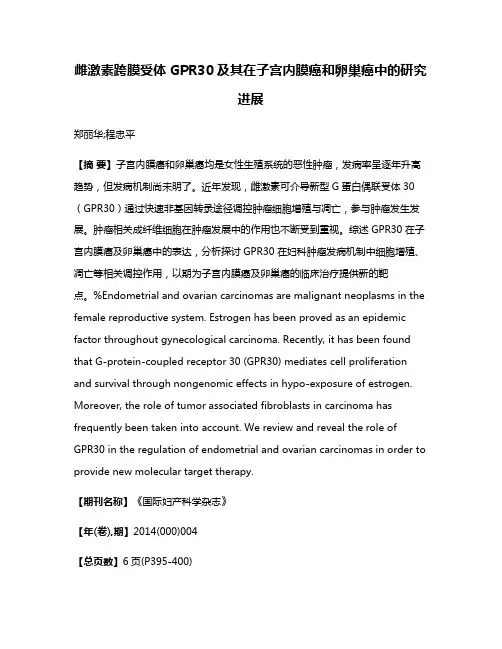
雌激素跨膜受体GPR30及其在子宫内膜癌和卵巢癌中的研究进展郑丽华;程忠平【摘要】子宫内膜癌和卵巢癌均是女性生殖系统的恶性肿瘤,发病率呈逐年升高趋势,但发病机制尚未明了。
近年发现,雌激素可介导新型G蛋白偶联受体30(GPR30)通过快速非基因转录途径调控肿瘤细胞增殖与凋亡,参与肿瘤发生发展。
肿瘤相关成纤维细胞在肿瘤发展中的作用也不断受到重视。
综述GPR30在子宫内膜癌及卵巢癌中的表达,分析探讨GPR30在妇科肿瘤发病机制中细胞增殖、凋亡等相关调控作用,以期为子宫内膜癌及卵巢癌的临床治疗提供新的靶点。
%Endometrial and ovarian carcinomas are malignant neoplasms in the female reproductive system. Estrogen has been proved as an epidemic factor throughout gynecological carcinoma. Recently, it has been found that G-protein-coupled receptor 30 (GPR30) mediates cell proliferation and survival through nongenomic effects in hypo-exposure of estrogen. Moreover, the role of tumor associated fibroblasts in carcinoma has frequently been taken into account. We review and reveal the role of GPR30 in the regulation of endometrial and ovarian carcinomas in order to provide new molecular target therapy.【期刊名称】《国际妇产科学杂志》【年(卷),期】2014(000)004【总页数】6页(P395-400)【关键词】受体,G蛋白偶联;癌;子宫内膜肿瘤;卵巢肿瘤;成纤维细胞【作者】郑丽华;程忠平【作者单位】200090 同济大学附属杨浦医院上海市杨浦区中心医院妇产科;200090 同济大学附属杨浦医院上海市杨浦区中心医院妇产科【正文语种】中文既往认为,雌激素的生物学功能主要由经典的雌激素受体(estrogen receptor,ER)包括ERα、ERβ介导的核内转录效应及机制不明确的快速非转录信号效应作用[1]。
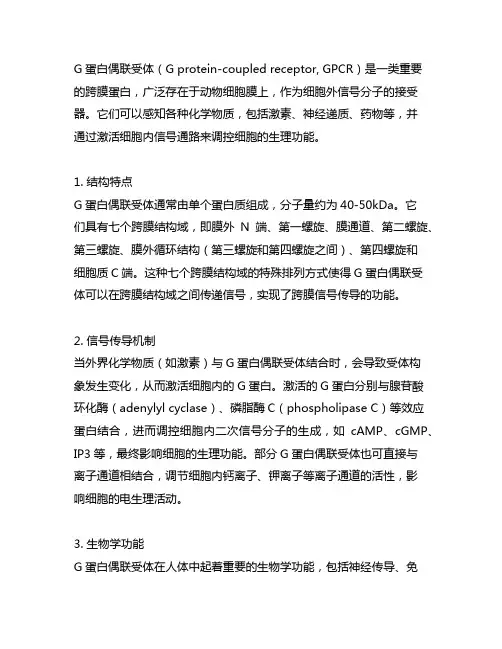
G蛋白偶联受体(G protein-coupled receptor, GPCR)是一类重要的跨膜蛋白,广泛存在于动物细胞膜上,作为细胞外信号分子的接受器。
它们可以感知各种化学物质,包括激素、神经递质、药物等,并通过激活细胞内信号通路来调控细胞的生理功能。
1. 结构特点G蛋白偶联受体通常由单个蛋白质组成,分子量约为40-50kDa。
它们具有七个跨膜结构域,即膜外N端、第一螺旋、膜通道、第二螺旋、第三螺旋、膜外循环结构(第三螺旋和第四螺旋之间)、第四螺旋和细胞质C端。
这种七个跨膜结构域的特殊排列方式使得G蛋白偶联受体可以在跨膜结构域之间传递信号,实现了跨膜信号传导的功能。
2. 信号传导机制当外界化学物质(如激素)与G蛋白偶联受体结合时,会导致受体构象发生变化,从而激活细胞内的G蛋白。
激活的G蛋白分别与腺苷酸环化酶(adenylyl cyclase)、磷脂酶C(phospholipase C)等效应蛋白结合,进而调控细胞内二次信号分子的生成,如cAMP、cGMP、IP3等,最终影响细胞的生理功能。
部分G蛋白偶联受体也可直接与离子通道相结合,调节细胞内钙离子、钾离子等离子通道的活性,影响细胞的电生理活动。
3. 生物学功能G蛋白偶联受体在人体中起着重要的生物学功能,包括神经传导、免疫应答、细胞增殖和分化、代谢调控等方面。
肾上腺素受体、乙酰胆碱受体等G蛋白偶联受体在神经系统中调节神经递质的释放和感知,影响神经传导;组胺受体、血管紧张素受体等在血管内皮细胞中调节血管张力,影响血管收缩和扩张。
4. 药物靶点由于G蛋白偶联受体对人体生理功能的调控作用,它们成为了许多药物的重要靶点。
许多药物(如β受体阻滞剂、抗组胺药等)就是通过作用于G蛋白偶联受体来发挥其药理作用。
对G蛋白偶联受体的深入研究不仅有助于理解生物学功能的调节机制,还可以为新药的研发提供重要的靶标。
总结G蛋白偶联受体作为一类重要的细胞外信号接受器,在人体生理功能调控中扮演着重要的角色。
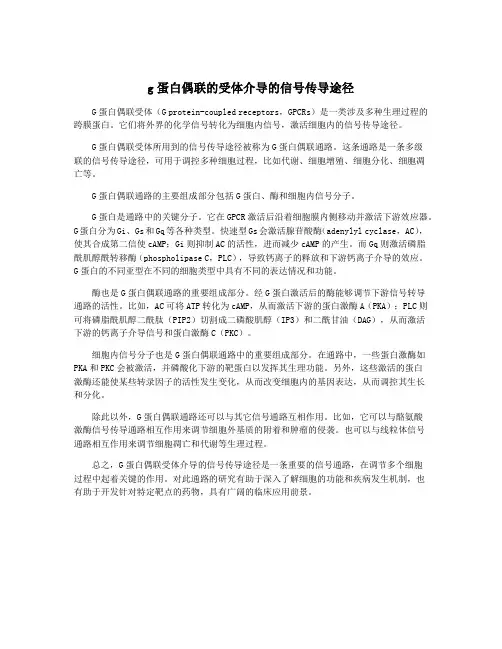
g蛋白偶联的受体介导的信号传导途径G蛋白偶联受体(G protein-coupled receptors,GPCRs)是一类涉及多种生理过程的跨膜蛋白。
它们将外界的化学信号转化为细胞内信号,激活细胞内的信号传导途径。
G蛋白偶联受体所用到的信号传导途径被称为G蛋白偶联通路。
这条通路是一条多级联的信号传导途径,可用于调控多种细胞过程,比如代谢、细胞增殖、细胞分化、细胞凋亡等。
G蛋白偶联通路的主要组成部分包括G蛋白、酶和细胞内信号分子。
G蛋白是通路中的关键分子。
它在GPCR激活后沿着细胞膜内侧移动并激活下游效应器。
G蛋白分为Gi、Gs和Gq等各种类型。
快速型Gs会激活腺苷酸酶(adenylyl cyclase,AC),使其合成第二信使cAMP;Gi则抑制AC的活性,进而减少cAMP的产生。
而Gq则激活磷脂酰肌醇酰转移酶(phospholipase C,PLC),导致钙离子的释放和下游钙离子介导的效应。
G蛋白的不同亚型在不同的细胞类型中具有不同的表达情况和功能。
酶也是G蛋白偶联通路的重要组成部分。
经G蛋白激活后的酶能够调节下游信号转导通路的活性。
比如,AC可将ATP转化为cAMP,从而激活下游的蛋白激酶A(PKA);PLC则可将磷脂酰肌醇二酰肽(PIP2)切割成二磷酸肌醇(IP3)和二酰甘油(DAG),从而激活下游的钙离子介导信号和蛋白激酶C(PKC)。
细胞内信号分子也是G蛋白偶联通路中的重要组成部分。
在通路中,一些蛋白激酶如PKA和PKC会被激活,并磷酸化下游的靶蛋白以发挥其生理功能。
另外,这些激活的蛋白激酶还能使某些转录因子的活性发生变化,从而改变细胞内的基因表达,从而调控其生长和分化。
除此以外,G蛋白偶联通路还可以与其它信号通路互相作用。
比如,它可以与酪氨酸激酶信号传导通路相互作用来调节细胞外基质的附着和肿瘤的侵袭。
也可以与线粒体信号通路相互作用来调节细胞凋亡和代谢等生理过程。
总之,G蛋白偶联受体介导的信号传导途径是一条重要的信号通路,在调节多个细胞过程中起着关键的作用。
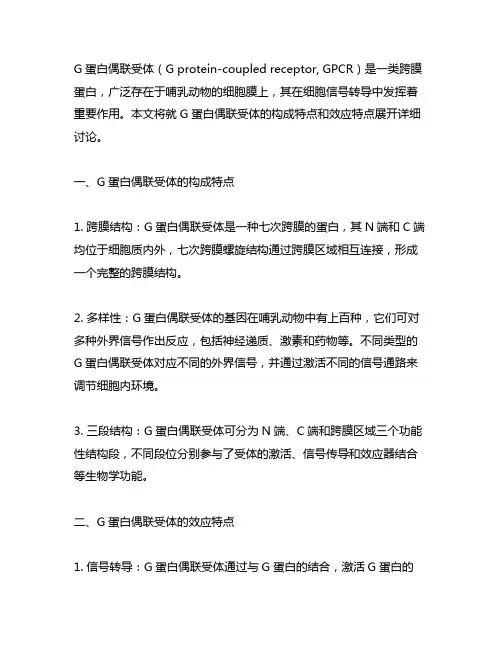
G蛋白偶联受体(G protein-coupled receptor, GPCR)是一类跨膜蛋白,广泛存在于哺乳动物的细胞膜上,其在细胞信号转导中发挥着重要作用。
本文将就G蛋白偶联受体的构成特点和效应特点展开详细讨论。
一、G蛋白偶联受体的构成特点1. 跨膜结构:G蛋白偶联受体是一种七次跨膜的蛋白,其N端和C端均位于细胞质内外,七次跨膜螺旋结构通过跨膜区域相互连接,形成一个完整的跨膜结构。
2. 多样性:G蛋白偶联受体的基因在哺乳动物中有上百种,它们可对多种外界信号作出反应,包括神经递质、激素和药物等。
不同类型的G蛋白偶联受体对应不同的外界信号,并通过激活不同的信号通路来调节细胞内环境。
3. 三段结构:G蛋白偶联受体可分为N端、C端和跨膜区域三个功能性结构段,不同段位分别参与了受体的激活、信号传导和效应器结合等生物学功能。
二、G蛋白偶联受体的效应特点1. 信号转导:G蛋白偶联受体通过与G蛋白的结合,激活G蛋白的GTP酶活性,从而使其从α亚基上失活的GDP变为活化的GTP。
活化的G蛋白可以调控细胞内的第二信使产生,如腺苷酸环化酶和磷脂酰肌醇磷酸途径等。
2. 多效性:G蛋白偶联受体的信号传导路径多样,可以通过激活腺苷酸环化酶的cAMP信号通路、磷脂酰肌醇信号通路、小G蛋白信号通路等多种途径发挥多种效应。
这种多效性使得G蛋白偶联受体在细胞生理和药理过程中具有广泛的作用。
3. 药物靶点:由于G蛋白偶联受体在细胞信号转导中的重要性,它成为了药物开发的重要靶点。
许多目前临床上使用的药物即是通过调控G蛋白偶联受体来发挥治疗作用的,这包括β受体阻滞剂、5-羟色胺受体拮抗剂等。
G蛋白偶联受体作为重要的细胞信号传导分子,其构成特点和效应特点对于我们理解细胞功能和研发药物具有重要意义。
对G蛋白偶联受体进行深入研究,有助于揭示其在疾病发生发展中的作用机制,为新药的设计提供理论依据。
希望未来能有更多的研究能够揭示G蛋白偶联受体的更多奥秘,为医学科研和临床治疗带来新的突破。
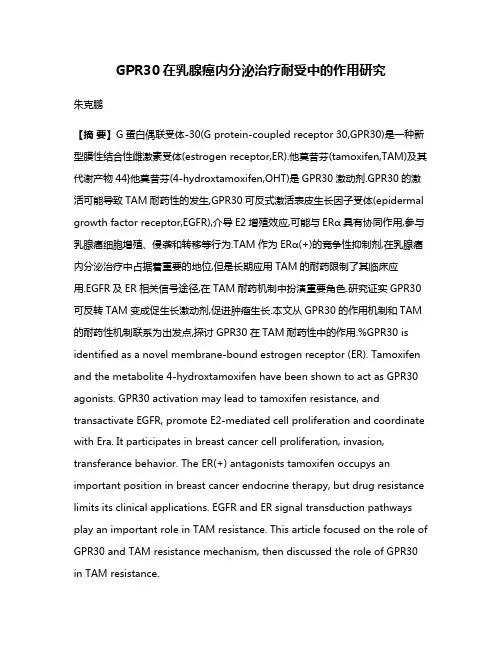
GPR30在乳腺癌内分泌治疗耐受中的作用研究朱克鹏【摘要】G蛋白偶联受体-30(G protein-coupled receptor 30,GPR30)是一种新型膜性结合性雌激素受体(estrogen receptor,ER).他莫昔芬(tamoxifen,TAM)及其代谢产物44}他莫昔芬(4-hydroxtamoxifen,OHT)是GPR30激动剂.GPR30的激活可能导致TAM耐药性的发生,GPR30可反式激活表皮生长因子受体(epidermal growth factor receptor,EGFR),介导E2增殖效应,可能与ERα具有协同作用,参与乳腺癌细胞增殖、侵袭和转移等行为.TAM作为ERα(+)的竞争性抑制剂,在乳腺癌内分泌治疗中占据着重要的地位,但是长期应用TAM的耐药限制了其临床应用.EGFR及ER相关信号途径,在TAM耐药机制中扮演重要角色.研究证实GPR30可反转TAM变成促生长激动剂,促进肿瘤生长.本文从GPR30的作用机制和TAM 的耐药性机制联系为出发点,探讨GPR30在TAM耐药性中的作用.%GPR30 is identified as a novel membrane-bound estrogen receptor (ER). Tamoxifen and the metabolite 4-hydroxtamoxifen have been shown to act as GPR30 agonists. GPR30 activation may lead to tamoxifen resistance, and transactivate EGFR, promote E2-mediated cell proliferation and coordinate with Era. It participates in breast cancer cell proliferation, invasion, transferance behavior. The ER(+) antagonists tamoxifen occupys an important position in breast cancer endocrine therapy, but drug resistance limits its clinical applications. EGFR and ER signal transduction pathways play an important role in TAM resistance. This article focused on the role of GPR30 and TAM resistance mechanism, then discussed the role of GPR30 in TAM resistance.【期刊名称】《中国癌症杂志》【年(卷),期】2011(021)008【总页数】6页(P648-653)【关键词】G蛋白偶联受体-30;他莫昔芬;耐药;表皮生长因子受体【作者】朱克鹏【作者单位】重庆医科大学附属第一医院普外科,重庆,400016【正文语种】中文【中图分类】R730.53内分泌治疗是乳腺癌患者综合治疗的重要组成部分,他莫昔芬(tam oxifen,TAM)属于选择性雌激素受体调节剂(selective estrogen receptor modulator,SE RM)类药物,是目前最基础、有效,且运用历史最悠久的一线内分泌治疗药物,但一旦发生耐药,TAM反而会促进肿瘤的生长。
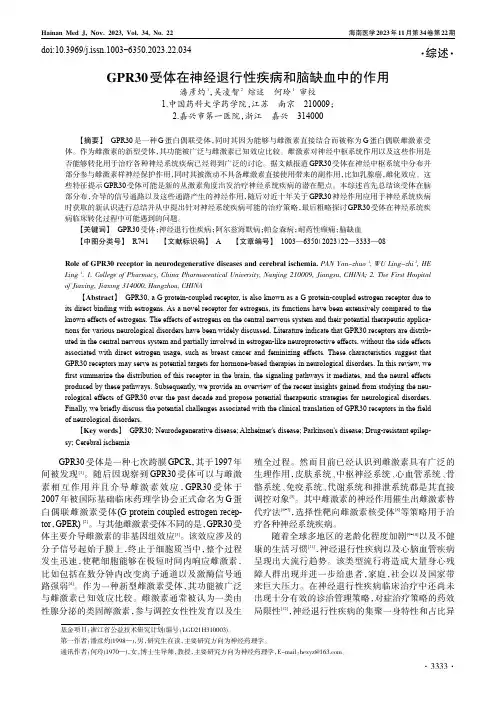
GPR30受体在神经退行性疾病和脑缺血中的作用潘彦灼1,吴凌智2综述何玲1审校1.中国药科大学药学院,江苏南京210009;2.嘉兴市第一医院,浙江嘉兴314000【摘要】GPR30是一种G 蛋白偶联受体,同时其因为能够与雌激素直接结合而被称为G 蛋白偶联雌激素受体。
作为雌激素的新型受体,其功能被广泛与雌激素已知效应比较。
雌激素对神经中枢系统作用以及这些作用是否能够转化用于治疗各种神经系统疾病已经得到广泛的讨论。
据文献报道GPR30受体在神经中枢系统中分布并部分参与雌激素样神经保护作用,同时其被激动不具备雌激素直接使用带来的副作用,比如乳腺癌,雌化效应。
这些特征提示GPR30受体可能是新的从激素角度出发治疗神经系统疾病的潜在靶点。
本综述首先总结该受体在脑部分布,介导的信号通路以及这些通路产生的神经作用,随后对近十年关于GPR30神经作用应用于神经系统疾病时获取的新认识进行总结并从中提出针对神经系统疾病可能的治疗策略,最后粗略探讨GPR30受体在神经系统疾病临床转化过程中可能遇到的问题。
【关键词】GPR30受体;神经退行性疾病;阿尔兹海默病;帕金森病;耐药性癫痫;脑缺血【中图分类号】R741【文献标识码】A 【文章编号】1003—6350(2023)22—3333—08Role of GPR30receptor in neurodegenerative diseases and cerebral ischemia.PAN Yan-zhuo 1,WU Ling-zhi 2,HE Ling 1.1.College of Pharmacy,China Pharmaceutical University,Nanjing 210009,Jiangsu,CHINA;2.The First Hospital of Jiaxing,Jiaxing 314000,Hangzhou,CHINA【Abstract 】GPR30,a G protein-coupled receptor,is also known as a G protein-coupled estrogen receptor due to its direct binding with estrogens.As a novel receptor for estrogens,its functions have been extensively compared to the known effects of estrogens.The effects of estrogens on the central nervous system and their potential therapeutic applica-tions for various neurological disorders have been widely discussed.Literature indicate that GPR30receptors are distrib-uted in the central nervous system and partially involved in estrogen-like neuroprotective effects,without the side effects associated with direct estrogen usage,such as breast cancer and feminizing effects.These characteristics suggest that GPR30receptors may serve as potential targets for hormone-based therapies in neurological disorders.In this review,we first summarize the distribution of this receptor in the brain,the signaling pathways it mediates,and the neural effects produced by these pathways.Subsequently,we provide an overview of the recent insights gained from studying the neu-rological effects of GPR30over the past decade and propose potential therapeutic strategies for neurological disorders.Finally,we briefly discuss the potential challenges associated with the clinical translation of GPR30receptors in the field of neurological disorders.【Key words 】GPR30;Neurodegenerative disease;Alzheimer's disease;Parkinson's disease;Drug-resistant epilep-sy;Cerebral ischemia ·综述·doi:10.3969/j.issn.1003-6350.2023.22.034基金项目:浙江省公益技术研究计划(编号:LGD21H310003)。
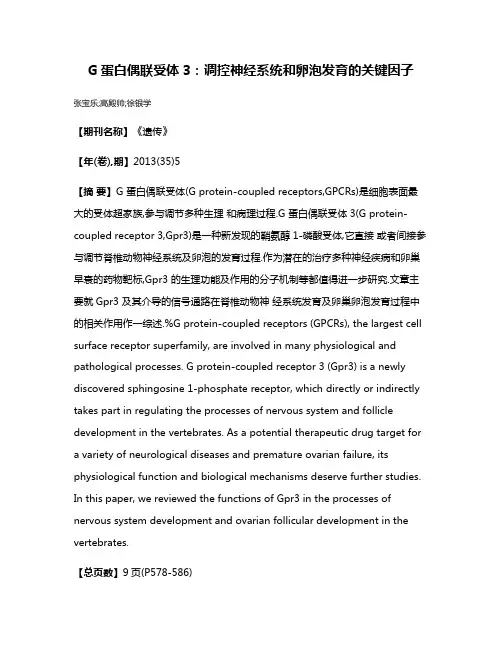
G蛋白偶联受体3:调控神经系统和卵泡发育的关键因子张宝乐;高殿帅;徐银学【期刊名称】《遗传》【年(卷),期】2013(35)5【摘要】G 蛋白偶联受体(G protein-coupled receptors,GPCRs)是细胞表面最大的受体超家族,参与调节多种生理和病理过程.G 蛋白偶联受体3(G protein-coupled receptor 3,Gpr3)是一种新发现的鞘氨醇1-磷酸受体,它直接或者间接参与调节脊椎动物神经系统及卵泡的发育过程.作为潜在的治疗多种神经疾病和卵巢早衰的药物靶标,Gpr3 的生理功能及作用的分子机制等都值得进一步研究.文章主要就Gpr3 及其介导的信号通路在脊椎动物神经系统发育及卵巢卵泡发育过程中的相关作用作一综述.%G protein-coupled receptors (GPCRs), the largest cell surface receptor superfamily, are involved in many physiological and pathological processes. G protein-coupled receptor 3 (Gpr3) is a newly discovered sphingosine 1-phosphate receptor, which directly or indirectly takes part in regulating the processes of nervous system and follicle development in the vertebrates. As a potential therapeutic drug target for a variety of neurological diseases and premature ovarian failure, its physiological function and biological mechanisms deserve further studies. In this paper, we reviewed the functions of Gpr3 in the processes of nervous system development and ovarian follicular development in the vertebrates.【总页数】9页(P578-586)【作者】张宝乐;高殿帅;徐银学【作者单位】徐州医学院神经生物学教研室,徐州,221002;南京农业大学动物科学技术学院,南京,210095;徐州医学院神经生物学教研室,徐州,221002;南京农业大学动物科学技术学院,南京,210095【正文语种】中文【相关文献】1.乙草胺对大鼠肝细胞G蛋白偶联受体介导的胞浆钙离子振荡的调控 [J], 张彬彬; 王玖2.G蛋白偶联受体在眼科疾病发生发展过程中的调控作用 [J], 魏慧霞;郝一宪;吴姗姗;於亭;毕宏生;郭大东3.G蛋白偶联受体在运动调控动脉舒张过程中的机制 [J], 于凤至;孙朋;刘淑卉4.运动调控骨代谢的关键膜上受体—G蛋白偶联受体48 [J], 陈祥和;杨康;赵仁清;孙开宏;蔡先锋5.非视紫质G蛋白偶联受体激酶对肿瘤的调控作用 [J], 李瑞瑞;蒋晓山因版权原因,仅展示原文概要,查看原文内容请购买。
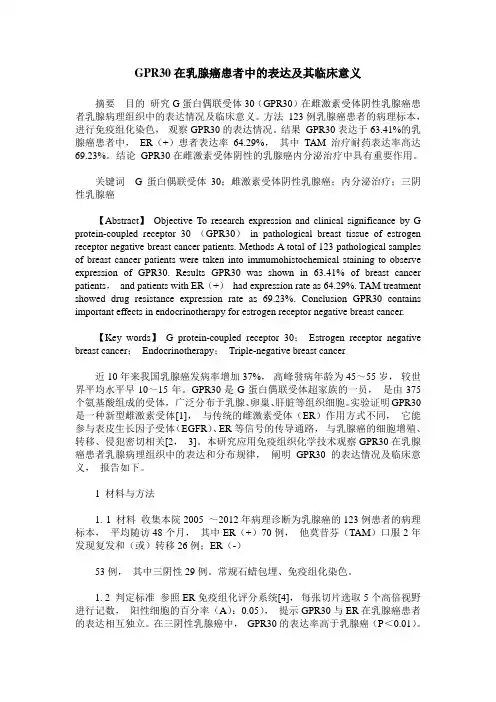
GPR30在乳腺癌患者中的表达及其临床意义摘要目的研究G蛋白偶联受体30(GPR30)在雌激素受体阴性乳腺癌患者乳腺病理组织中的表达情况及临床意义。
方法123例乳腺癌患者的病理标本,进行免疫组化染色,观察GPR30的表达情况。
结果GPR30表达于63.41%的乳腺癌患者中,ER(+)患者表达率64.29%,其中TAM治疗耐药表达率高达69.23%。
结论GPR30在雌激素受体阴性的乳腺癌内分泌治疗中具有重要作用。
关键词G蛋白偶联受体30;雌激素受体阴性乳腺癌;内分泌治疗;三阴性乳腺癌【Abstract】Objective To research expression and clinical significance by G protein-coupled receptor 30 (GPR30)in pathological breast tissue of estrogen receptor negative breast cancer patients. Methods A total of 123 pathological samples of breast cancer patients were taken into immumohistochemical staining to observe expression of GPR30. Results GPR30 was shown in 63.41% of breast cancer patients,and patients with ER(+)had expression rate as 64.29%. TAM treatment showed drug resistance expression rate as 69.23%. Conclusion GPR30 contains important effects in endocrinotherapy for estrogen receptor negative breast cancer.【Key words】G protein-coupled receptor 30;Estrogen receptor negative breast cancer;Endocrinotherapy;Triple-negative breast cancer近10年来我国乳腺癌发病率增加37%,高峰發病年龄为45~55岁,较世界平均水平早10~15年。
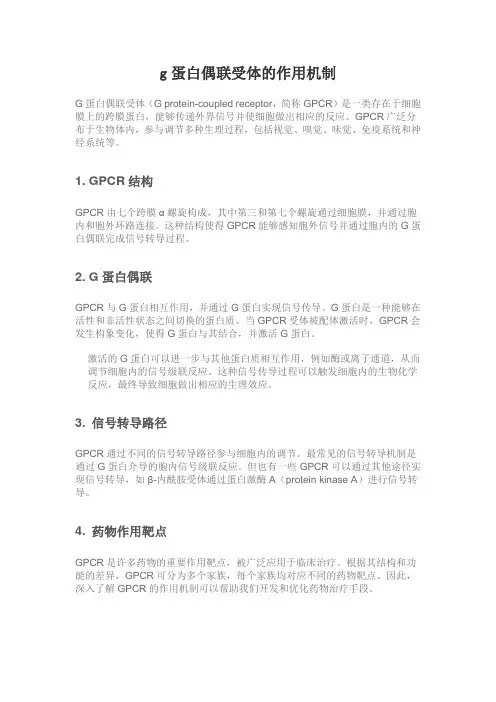
g蛋白偶联受体的作用机制
G蛋白偶联受体(G protein-coupled receptor,简称GPCR)是一类存在于细胞膜上的跨膜蛋白,能够传递外界信号并使细胞做出相应的反应。
GPCR广泛分布于生物体内,参与调节多种生理过程,包括视觉、嗅觉、味觉、免疫系统和神经系统等。
1. GPCR结构
GPCR由七个跨膜α螺旋构成,其中第三和第七个螺旋通过细胞膜,并通过胞内和胞外环路连接。
这种结构使得GPCR能够感知胞外信号并通过胞内的G蛋白偶联完成信号转导过程。
2. G蛋白偶联
GPCR与G蛋白相互作用,并通过G蛋白实现信号传导。
G蛋白是一种能够在活性和非活性状态之间切换的蛋白质。
当GPCR受体被配体激活时,GPCR会发生构象变化,使得G蛋白与其结合,并激活G蛋白。
激活的G蛋白可以进一步与其他蛋白质相互作用,例如酶或离子通道,从而调节细胞内的信号级联反应。
这种信号传导过程可以触发细胞内的生物化学反应,最终导致细胞做出相应的生理效应。
3. 信号转导路径
GPCR通过不同的信号转导路径参与细胞内的调节。
最常见的信号转导机制是通过G蛋白介导的胞内信号级联反应。
但也有一些GPCR可以通过其他途径实现信号转导,如β-内酰胺受体通过蛋白激酶A(protein kinase A)进行信号转导。
4. 药物作用靶点
GPCR是许多药物的重要作用靶点,被广泛应用于临床治疗。
根据其结构和功能的差异,GPCR可分为多个家族,每个家族均对应不同的药物靶点。
因此,深入了解GPCR的作用机制可以帮助我们开发和优化药物治疗手段。

G蛋白偶联受体的概念G蛋白偶联受体(G protein-coupled receptor,GPCR)是一类广泛分布在细胞膜表面的受体蛋白,它们在细胞信号传导中发挥着重要的作用。
当外源性或内源性信号分子与GPCR结合后,GPCR会激活相应的G蛋白,从而启动一系列细胞内信号传导通路,调控细胞的生理功能。
GPCR的结合位点GPCR的结合位点是指外源性或内源性信号分子与GPCR结合的特定区域,这个区域通常位于GPCR的细胞外部或跨膜区域。
结合位点的结构和特性决定了信号分子与GPCR的结合能力和亲和性。
常见的GPCR结合位点包括第一外部环(extracellular loop 1,ECL1)、第二外部环(extracellular loop 2,ECL2)、第三外部环(extracellular loop 3,ECL3)、第七跨膜区(transmembrane domain 7,TM7)等。
这些结合位点通常由氨基酸残基组成,它们的序列和空间构象对信号分子的结合和激活起着重要的作用。
GPCR与信号分子的结合当外源性或内源性信号分子进入细胞外环境后,它们会与GPCR的结合位点发生相互作用。
这种作用可以是非共价的,通过静电力、范德华力和氢键等相互作用力进行结合,也可以是共价的,通过特定的化学键形成稳定的结合。
信号分子结合到GPCR后,会引发GPCR的构象变化,从而激活G蛋白。
G蛋白是一类能够与GPCR相互作用的蛋白,它存在于细胞质中。
一旦G蛋白被激活,它会解离出GPCR,并激活下游的蛋白激酶或次级信号传导分子,最终调控细胞内的生理功能。
GPCR结合位点的研究方法研究GPCR结合位点的方法有很多种。
一种常用的方法是利用结构生物学技术,如X射线晶体学和核磁共振等,解析GPCR与信号分子的结合位点的三维结构。
这种方法可以提供高分辨率的结构信息,帮助我们理解GPCR与信号分子的相互作用机制。
另一种方法是利用生化技术,如放射性标记、质谱分析和蛋白结合实验等,研究GPCR与信号分子的结合亲和性和动力学性质。

G蛋白偶联受体的功能检测G蛋白偶联受体(G一protein一 coupledreceptors,GPeRs)家族参与了机体内多种生理过程的调节,是治疗多种人类疾病的主要药物靶点。
高通量药物筛选是一种优化的微量分析方法是药物研制开发早期的最重要的工具之一,利用这一技术能快速地进行大量药物筛选。
从中找到能选择性地作用于药靶的有生物活性的化合物.根据G蛋白偶联受体与配体结合及激发的信号通路,人们设计了各种可行的功能测试方法,对G蛋白偶联受体进行功能的检测,并应用于G蛋白偶联受体药物筛选和研发。
从测定对象来讲这些方法可分为3类:1、配体受体结合法;2、基于第二信使检测方法;3、报告基因测定法。
配体结合检测法是目前应用最广泛的G蛋白偶联受体检测方法。
下面简单介绍一些技术。
微体积荧光数字图像测定技术FMAT: 在这种方法中常使用荧光标记的内源配体!如果加入的小分子化合物从细胞表面的GPCR上取代了标记的荧光配体则这个孔中的细胞就不会产生荧光"说明这些化合物能够阻断标记配体与细胞表面受体之间的相互作用!通过激光扫描"产生来源于微孔平板每个微孔离底部0.1mm处1平方米的数字图像它反映了细胞荧光的大小和数量与此无关的荧光在数据处理时被忽略荧光信号的大小直接与结合到每个细胞配体的数量成比例。
荧光偏振FP: 荧光偏振用于测量两个试剂(其中一个进行荧光标记)竞争结合到受体上的情况。
通过对偏振光检测,检测结合到受体的小分子化合物。
结合到受体上的荧光标记的分子,由于被锚定在大分子上。
受偏振光激化后,发出的光会维持在同一个偏振平面上,而没有结合的分子由于自由旋转的能力大,发出的光不能处于同一个偏振面上,因而偏振光消失。
用偏振光激化后,通过测量发出的光在水平面与垂直平面上的强度来测量结合分子的量。
FP是一种敏感且准确的平板测定方法。
基于第二信使检测方法有很多,主要简述一下几种。
竞争性ELISA测定: 酶联免疫测定 (ELlSA)是一种极为敏感的检测方法,而且检测的物质非常广泛。
G蛋白偶联受体信号传导通路的分子机制研究G蛋白偶联受体(G protein-coupled receptors,GPCRs)是人类体内最大的膜受体家族之一,广泛参与了生理和病理过程中的信号转导通路。
近年来,G蛋白偶联受体的研究变得非常火热,人们对其分子机制的研究也越来越深入。
本文将从G 蛋白偶联受体信号传导通路的分子机制、调控机制和应用前景三个方面进行讨论。
一、G蛋白偶联受体信号传导通路的分子机制G蛋白偶联受体最重要的功能是通过其三个亚基(α、β和γ)与G蛋白结合,从而触发下游的信号转导通路。
G蛋白偶联受体的典型结构包括七个跨膜区域和一个C端区域,其中N端朝向胞外,C端朝向胞内,七个跨膜区域之间的环状区域是GPCRs的关键结构域。
GPCRs与内源性配体结合后,促使G蛋白中α亚基与GDP结合状态下的GTP 交换,α亚基独立于β和γ亚基并与下游分子直接相互作用,从而影响线粒体、离子通道、酶等下游效应器的酶活性或电位水平。
G蛋白偶联受体信号传导通路在许多重要的生理和病理过程中都起着重要的作用。
二、G蛋白偶联受体信号传导通路的调控机制大量的实验证明,与GPCRs结合的配体分子可以调控G蛋白α亚基与GTP或GDP结合的平衡状态,进而引起了效应器的反馈调节。
此外,调控G蛋白偶联受体配体结合、转运和稳定性的工作也具有巨大的发展潜力。
一些潜在的药物分子也能够影响G蛋白偶联受体的稳定性和位置,从而具有重要的药物治疗作用。
三、G蛋白偶联受体信号传导通路的应用前景G蛋白偶联受体是当今的一个热门生物医学研究领域,已经被广泛应用于药物研究和发现、抗癌药物研究、病毒和细胞介导的疾病研究,以及治疗其他疾病的药物研究。
随着技术的不断进步,G蛋白偶联受体的应用前景变得越来越广泛,这将为人类健康的促进和医疗的进步带来更多的机会和挑战。
总之,G蛋白偶联受体信号转导通路的分子机制、调控机制和应用前景是当今生物医学研究的重要方向之一。
进一步的研究将有助于揭示G蛋白偶联受体信号转导通路在人类健康、疾病治疗等领域的应用潜力,从而更好地服务于人类的健康事业。
GPR30在原发及复发性乳腺癌中的表达和意义的开题报告一、研究背景及意义乳腺癌是女性最常见的肿瘤之一,在患者的治疗和管理中,包括手术、化疗和内分泌治疗等多种方法。
然而,一些患者在接受治疗后仍会出现复发和转移。
因此,研究乳腺癌治疗和预后预测的新靶点十分必要。
G蛋白偶联受体30(G protein-coupled receptor 30, GPR30)是一种七次跨膜的蛋白,在乳腺组织中广泛表达。
研究表明,其在乳腺癌中的表达水平与病理分级、患者的预后密切相关。
此外,GPR30还与内分泌治疗的敏感性和耐药性相关。
因此,研究GPR30在原发及复发性乳腺癌中的表达及意义,对乳腺癌的临床治疗和预后评估有着重要的现实意义。
二、研究目的本研究旨在探究GPR30在原发及复发性乳腺癌中的表达及其与临床病理特征、内分泌治疗敏感性及预后的关系,为乳腺癌患者个体化治疗提供参考。
三、研究内容和方法①研究对象选择2012年至2018年到某医院就诊的乳腺癌患者,根据其诊断及治疗史分为两组:原发乳腺癌组和复发乳腺癌组。
②实验方法1.采用反转录-聚合酶链式反应(RT-PCR)检测GPR30 mRNA的表达水平;2.采用免疫组织化学(IHC)技术检测GPR30蛋白的表达水平;3.通过对患者的相关资料进行调查,分析GPR30表达与内分泌治疗敏感性、预后的关系。
③统计分析方法采用SPSS 22.0软件进行数据统计及分析,计量资料采用t检验或方差分析;计数资料采用卡方检验;Kaplan-Meier生存分析法用于分析生存曲线,Log-rank检验用于比较不同组之间的差异。
P<0.05为统计学差异有显著意义。
四、预期结果和意义本研究预期可以明确GPR30在乳腺癌中的表达情况及其与临床病理和预后的关系,为乳腺癌个体化治疗提供理论基础。
同时,本研究成果还有助于解明GPR30在乳腺癌发生和发展中的作用机制,为该领域的研究提供新思路。
专利名称:G PROTEIN-COUPLED RECEPTOR (GPCR)LIGAND ASSAY发明人:Sivaraj Sivaramakrishnan,Keehun Kim申请号:US16769852申请日:20181204公开号:US20210179692A1公开日:20210617专利内容由知识产权出版社提供专利附图:摘要:The systems and methods described herein include the use of Giant Plasma Membrane Vesicles (GPMVs) derived from cells expressing SPASM sensors (e.g., SPASM GPCR sensors). Herein provided are giant plasma membrane vesicle (GPMV) M sensorscontaining a membrane-associated polypeptide, where the membrane-associated polypeptide contains a target G protein-coupled receptor (GPCR), a linker including an amino acid sequence flanked by a FRET donor and a FRET acceptor, and a receptor partner for the target GPCR, where the linker separates the target GPCR from the receptor partner. In another aspect, provided is a method for quantifying the intrinsic efficacy of a compound for a target GPCR. In another aspect, provided is a method for identifying a compound that interacts with a target GPCR.申请人:REGENTS OF THE UNIVERSITY OF MINNESOTA地址:Minneapolis MN US国籍:US更多信息请下载全文后查看。
GPR30在胎盘组织中的差异表达及其与子痫前期的关系周丽媛;张华【期刊名称】《重庆医科大学学报》【年(卷),期】2015(40)6【摘要】目的:探讨胎盘组织中新型雌激素受体G-蛋白偶联受体30(g-protein coupled receptor 30,GPR30)的表达及其与子痫前期(preeclampsia,PE)发病的关系。
方法:收集重庆医科大学附属第一医院2012年1月至2014年5月分娩的20例PE和19例正常产妇的胎盘组织,应用免疫组化方法检测GPR30在胎盘组织中的表达。
然后以人脐静脉血管内皮细胞建立PE细胞模型,以免疫荧光技术和蛋白印迹技术(Western blot)检测GPR30蛋白的表达情况。
以流式细胞仪检测凋亡、以体外小管形成实验检测管腔成形能力、以迁移实验检测迁移能力等。
结果:GPR30在PE组胎盘组织中表达明显低于对照组(P=0.000);而在细胞模型中,经缺氧/复氧处理后,GPR30蛋白的表达降低(P=0.000);GPR30抑制剂-G15处理使其凋亡增加(P=0.000);而GPR30激动剂-G1能促进其管腔成形(P=0.000)和迁移(P=0.0015),同时,G15能抑制17β-雌二醇对其管腔成形(P=0.039)和迁移(P=0.014)的保护作用。
结论:GPR30表达下降可能与PE胎盘血管内皮细胞的功能异常相关。
【总页数】6页(P806-811)【关键词】子痫前期;G-蛋白偶联受体30;血管内皮【作者】周丽媛;张华【作者单位】重庆医科大学附属第一医院妇产科;重庆医科大学中国-加拿大-新西兰联合母胎医学实验室【正文语种】中文【中图分类】R714.1【相关文献】1.miRNA 在重度子痫前期与正常妊娠胎盘组织中差异表达的研究 [J], 蒋涛涛;孙波;沈梅;董洁;骆琦2.子痫前期患者胎盘、胎膜组织中水通道蛋白9的表达变化与子痫前期发病的关系[J], 刘照贞;颜建英;陈素清;许淑霞;黄海龙3.Nogo-B在子痫前期胎盘和正常胎盘组织中的差异表达及其与病情的相关性分析[J], 许芙蓉;王海燕4.GPR30在子痫前期胎盘组织和正常胎盘组织中的差异表达及其临床意义 [J], 冯本周5.miR200c、E -Cad 和 ZEB1在子痫前期患者胎盘组织中的差异表达 [J], 王豫红;高玲因版权原因,仅展示原文概要,查看原文内容请购买。
G蛋白偶联受体30在大鼠蛛网膜下腔出血后对神经炎症和血脑屏障破坏的影响李智勇;陈政纲;彭俊【期刊名称】《国际神经病学神经外科学杂志》【年(卷),期】2024(51)2【摘要】目的探讨G蛋白偶联受体30(GPR30)在大鼠蛛网膜下腔出血(SAH)早期脑损伤(EBI)过程中对神经炎症和血脑屏障(BBB)破坏的影响。
方法36只雄性大鼠随机分为6组(n=6/组):假手术(Sham)组,SAH(3 h、6 h、12 h、24 h、72 h)组。
此外,72只大鼠随机分为4组(n=18/组):Sham组、SAH组、SAH联合过表达GPR30慢病毒阴性载体(SAH+Lv-NC)组、SAH联合过表达GPR30慢病毒载体(SAH+Lv-GPR30)组。
通过血管内穿孔建立SAH模型,于SHA大鼠脑室内注射Lv-GPR30。
通过神经学评分、脑组织含水量(BWC)检测、伊文思蓝(EBP)染色、苏木精和伊红(HE)染色来分析GPR30对EBI的影响;采用蛋白质印迹法(Western blotting)和实时荧光定量PCR(qRT-PCR)分析各种蛋白质和转录水平;通过酶联免疫吸附测定法(ELISA)分别测定肿瘤坏死因子α(TNF-α)、白细胞介素6(IL-6)、白细胞介素1β(IL-1β)、白细胞介素10(IL-10)水平。
结果SAH大鼠脑内注射Lv-GPR30后脑组织中GPR30的表达增加,并改善了大鼠神经功能、神经炎症、BBB 破坏和脑水肿程度。
过表达GPR30抑制SAH大鼠脑组织中基质金属蛋白肽酶9(MMP-9)和基质金属蛋白肽酶2(MMP-2)的表达,以及炎症因子TNF-α、IL-6、IL-1β表达水平,同时提高IL-10的表达水平。
结论GPR30能减轻SAH大鼠的神经炎症和BBB破坏。
【总页数】6页(P29-34)【作者】李智勇;陈政纲;彭俊【作者单位】海南医学院第一附属医院医疗质量管理科;海南医学院第一附属医院神经外科;中南大学湘雅医学院附属海口医院神经外科【正文语种】中文【中图分类】R743【相关文献】1.抑制Nod样受体蛋白3减轻大鼠蛛网膜下腔出血后血脑屏障破坏和神经功能缺损的研究2.甘草甜素通过抑制炎症反应和氧化应激改善大鼠蛛网膜下腔出血后血脑屏障损伤3.依达拉奉对大鼠脑栓塞后炎症体Nod样受体蛋白3及血脑屏障相关蛋白的影响4.头孢曲松对大鼠蛛网膜下腔出血后血脑屏障及神经细胞凋亡的影响5.白蛋白对老年大鼠全脑缺血再灌注后G蛋白偶联受体124表达和血脑屏障的影响因版权原因,仅展示原文概要,查看原文内容请购买。
The G Protein-Coupled Receptor GPR30Mediates the Proliferative Effects Induced by 17-Estradiol and Hydroxytamoxifen in Endometrial Cancer CellsAdele Vivacqua,*Daniela Bonofiglio,*Anna Grazia Recchia,Anna Maria Musti,Didier Picard,Sebastiano Ando `,and Marcello Maggiolini Departments of Pharmaco-Biology (A.V.,D.B.,A.G.R.,A.M.M.,M.M.)and Cellular Biology (S.A.),University of Calabria,87030Rende (Cosenza),Italy;and Department of Cellular Biology (D.P.),University of Geneva,1211Geneva,SwitzerlandThe growth of both normal and transformed epi-thelial cells of the female reproductive system is stimulated by estrogens,mainly through the acti-vation of estrogen receptor ␣(ER ␣),which is a ligand-regulated transcription factor.The selective ER modulator tamoxifen (TAM)has been widely used as an ER antagonist in breast tumor;how-ever,long-term treatment is associated with an increased risk of endometrial cancer.To provide new insights into the potential mechanisms in-volved in the agonistic activity exerted by TAM in the uterus,we evaluated the potential of 4-hy-droxytamoxifen (OHT),the active metabolite of TAM,to transactivate wild-type ER ␣and its splice variant expressed in Ishikawa and HEC1A endome-trial tumor cells,respectively.OHT was able to antagonize only the activation of ER ␣by 17-es-tradiol (E2)in Ishikawa cells,whereas it up-regu-lated c-fos expression in a rapid manner similar to E2and independently of ER ␣in both cell lines.This stimulation occurred through the G protein-cou-pled receptor named GPR30and required Src-re-lated and epidermal growth factor receptor ty-rosine kinase activities,along with the activation of both ERK1/2and phosphatidylinositol 3-kinase/AKT pathways.Most importantly,OHT,like E2,stimulated the proliferation of Ishikawa as well as HEC1A cells.Transfecting a GPR30antisense ex-pression vector in both endometrial cancer cell lines,OHT was no longer able to induce growth effects,whereas the proliferative response to E2was completely abrogated only in HEC1A cells.Furthermore,in the presence of the inhibitors of MAPK and phosphatidylinositol 3-kinase path-ways,PD 98059and wortmannin,respectively,E2and OHT did not elicit growth stimulation.Our data demonstrate a new mode of action of E2and OHT in endometrial cancer cells,contributing to a better understanding of the molecular mechanisms in-volved in their uterine agonistic activity.(Molecular Endocrinology 20:631–646,2006)ESTROGENS ARE PLEIOTROPIC hormones that regulate the growth and differentiation of many tissues.Acting as mitogens,they also promote the development of breast and endometrial tumors,which cumulatively account for about 40%of cancer inci-dence among women (1).The classical mechanism of action of 17-estradiol (E2)(1)involves binding to es-trogen receptors (ER)␣and ,which interact with theestrogen response elements (EREs)located in the reg-ulatory region of target genes (2,3).It is well known that the ERs contain two main transcription activation functions (AF):the N-terminal AF1and the C-terminal AF2,which is associated with the ligand-binding do-main responsible for hormone-dependent transactiva-tion (4,5).The involvement of both AF1and AF2in ER-mediated transcriptional activity depends on the cell and promoter examined,because in a certain con-text an individual domain functions as the only deter-minant,whereas in other cases AF2acting in combi-nation with AF1elicits the maximal potency in the ER response (4,6,7).Approximately 50%of all breast cancers express elevated levels of ER ␣(8),and prolonged exposure to E2is a major risk factor for breast tumor progression (9).Consequently,ER ␣antagonists such as tamoxifen (TAM),ICI 182,780(ICI),and raloxifene have been used in the front-line pharmacological management of ER ␣-positive breast cancers to inhibit the mitogenic action of E2(10–14).Although originally considered an antiestrogen,TAM is now classified as a selective ER modulator because in the breast it functions as anFirst Published Online October 20,2005*A.V.and D.B.contributed equally to this work.Abbreviations:AF,Activation function;AP1,activating pro-tein 1;AS-ODN,antisense oligonucleotide;Cx,cyclohexi-mide;DEX,dexamethasone;DHT,5␣-dihydrotestosterone;DN,dominant negative;E2,17-estradiol;EGF,epidermal growth factor;EGFR,epidermal growth factor receptor;ER,estrogen receptor;ERE,estrogen-responsive element;FBS,fetal bovine serum;GPCR,G protein-coupled receptor;ICI,ICI 182,780;OHT,hydroxytamoxifen;PD,PD 98059;PI3K,phosphatidylinositol 3-kinase;PR,progesterone receptor;PRG,progesterone;PT,pertussis toxin;SRE,serum re-sponse element;TAM,tamoxifen;WM,wortmannin.Molecular Endocrinology is published monthly by The Endocrine Society (),the foremost professional society serving the endocrine community.0888-8809/06/$15.00/0Molecular Endocrinology 20(3):631–646Printed in U.S.A.Copyright ©2006by The Endocrine Societydoi:10.1210/me.2005-0280631antagonist,whereas in the uterus,bone,and the car-diovascular system it displays agonistic activity(15, 16).Furthermore,TAM can induce uterine cell growth in vivo in animal models(17)as well as in humans(18, 19).Also,the active metabolite of TAM,4-hydroxyta-moxifen(OHT),stimulates the proliferation of both hu-man endometria(20,21)and cultured human endo-metrial carcinoma cells(21,22).Many molecular mechanisms have been proposed to explain this phe-nomenon;however,it still remains to be completely elucidated.In normal and neoplastic uterine tissue,the expres-sion of full-length ERa mRNA is generally greater than the expression of a given splice variant(23,24).Oc-casionally,ER␣mRNA splice variants are translated into proteins that may act either as dominant-positive or dominant-negative(DN)vs.the wild-type ER␣(25). In addition,an altered expression of ER coregulators has been associated with the progression of breast cancers toward a more malignant and TAM-resistant phenotype(26).The involvement of coactivators to promote TAM agonism may represent a relevant hy-pothesis;however,alteration of their expression pat-terns did not parallel the development of endometrial malignancy(27).The tissue-specific effects of TAM may follow the activation of cellular signaling path-ways,including ER␣phosphorylation at both serine 118and167,as well as the MAPK kinase kinase 1-dependent increase in TAM agonistic activity(28).A large number of studies have also been performed toward the identification of membrane-associated es-trogen signals that may alter gene expression inde-pendently of the nuclear ERs.Intriguingly,recent re-ports,including our own(29–31),have described the estrogen-binding and activation properties of a G pro-tein-coupled receptor(GPCR)named GPR30,which has therefore been proposed as a candidate for trig-gering a broad range of rapid E2activity at the plasma membrane level.In this respect,we have demon-strated that in breast cancer cells lacking ERs,GPR30 mediates up-regulation of the c-fos protooncogene by either E2or estrogen-like compounds,such as the phytoestrogens genistein and quercetin(29).c-fos is a classical early gene whose expression is rapidly and transiently induced by different extracellular stimuli, including mitogens and hormones(32–38).The nu-clear protein encoded by c-fos interacts with c-jun family members to form the heterodimeric activating protein1(AP1)transcription factor(39–42),which reg-ulates a series of genes as well as interacting proteins (43–48).The transcription of c-fos is controlled by multiple cis elements,such as the cAMP response element(49),the signal transducers and activators of transcription group of transcription factors(50),and the serum response element(SRE),which recruits the ternary complex factors,including Elk-1and serum-response factor accessory proteins1and2(51–55). As it concerns ER␣,binding to the imperfect palin-dromic ERE sequence within the c-fos promoter is not sufficient for transactivation because it requires inter-action of ER␣with a downstream Sp1site(56).Be-sides,it has been reported that E2signaling may con-verge on the SRE target sequence through a nongenomic ER␣pathway leading to MAPK-depen-dent phosphorylation and binding of Elk-1to the SRE sequence(57).In the present study we show that E2and OHT up-regulate c-fos expression in a rapid manner through the membrane-associated GPR30protein in Ishikawa and HEC1A human endometrial cancer cells. Our results provide new insights into the molecular mechanisms by which OHT exerts a growth stimula-tory action in these uterine tumor cells.RESULTSE2,But Not OHT,Transactivates and Down-Regulates ER␣in Ishikawa CellsConsidering the controversies regarding the ability of E2and OHT to activate the endogenous and/or over-expressed ER␣in Ishikawa cells(25,58–60),we first examined whether a transiently transfected ER re-porter gene responds to both ER ligands.E2induced a dose-dependent luciferase expression,whereas OHT as well as ICI were not able to activate ER␣in the concentration range used(Fig.1A).However,10M of both ER antagonists repressed the luciferase activity elicited by100n M E2(Fig.1B).An additional hallmark of ER␣activation by an agonist is represented by reduction of its expression consequent to the high turnover of the E2-activated receptor protein and the transcription inhibition of its own gene(61).Hence,we investigated whether the levels of ER␣contained in Ishikawa cells could be regulated by E2and OHT. Western analysis of ER␣performed with an anti-ER␣antibody raised against the C-terminus region recog-nized a protein corresponding to the size of wild-type ER␣(66kDa;Fig.1,C and E).In addition,the ER␣antibody recognized a protein with a smaller size(Ͻ48 kDa;Fig.1,C and E),which was no longer detected using an anti-ER␣antibody raised against the N-ter-minus domain(data not shown).Short treatments did not modify the levels of ER␣and its variant(Fig.1,C and D),whereas a12-h exposure to E2markedly re-duced the content of wild-type ER␣(Fig.1,E and F). As it concerns ERexpression,no changes were ob-served in either of the ligands used(Fig.1,C and D, and E and F).Overall,these findings indicate that in Ishikawa cells the transcriptional activation of endog-enous ER␣gene is dependent on E2,whereas OHT exerts an antagonist activity.E2and OHT Neither Transactivate Nor Regulate the ER␣Splice Variant Expressed in HEC1A Next,we evaluated the potential transcriptional effects of E2and OHT in HEC1A human endometrial cancer cells,because ER expression and E2responsiveness632Mol Endocrinol,March2006,20(3):631–646Vivacqua et al.•GPR30Function in Endometrial Cancer Cellsare still controversial in these cells (62–67).In agree-ment with previous reports (63,65,67),we did not detect any ERE-mediated transcriptional activity on E2,OHT,or ICI in the concentration range used (Fig.2A).Furthermore,E2and OHT had no effect on the protein levels of ER or the ER ␣splice variantcon-Fig.1.E2,But Not OHT,Activates and Down-Regulates Wild-Type ER ␣in Ishikawa CellsIshikawa cells were transfected with the luciferase reporter plasmid XETL and treated with increasing concentrations of E2,OHT,and ICI (A)or with 100n M E2,10M OHT,and ICI alone or in combination as indicated (B).The luciferase activities were normalized to the internal transfection control,and values of untreated cells (Ϫ)were set as 1-fold induction upon which the activity induced by treatments was calculated.Each data point represents the mean ϮSD of three independent experiments performed in triplicate.Ⅺ,P Ͻ0.05for untreated (Ϫ)vs.E2-treated cells;f ,P Ͻ0.05for E2-treated cells vs.those treated with E2and OHT or ICI.C and E,Immunoblots of ER ␣and ER from Ishikawa cells treated with 1M E2or OHT for the indicated times.-Actin serves as a loading control.D and F,Quantitative representations of data (mean ϮSD )from three independent experiments including those in C and E,respectively.Ⅺ,P Ͻ0.05for untreated (Ϫ)vs.E2-treated cells.Vivacqua et al.•GPR30Function in Endometrial Cancer Cells Mol Endocrinol,March 2006,20(3):631–646633tained in HEC1A cells (Fig.2,B and C,and D and E).Collectively,these results suggest that the ER ␣splice variant expressed in the endometrial cancer cells used is not able to induce ERE-mediated transcriptional activity or to act as a DN form of wild-type ER ␣.E2and OHT Transactivate c-fos Promoter Constructs in Ishikawa CellsHaving established that OHT acts as an antagonist of the classical ER ␣-ERE pathway in Ishikawa cancer cells,we examined its ability to activate a transiently transfected full-length human c-fos promoter (Ϫ2.2kb),which contains several target sequences re-sponding to a variety of extracellular stimuli (32–38).Interestingly,E2and OHT,but not ICI,were able to transactivate c-fos in an ERE-independent manner,because an ERE deletion mutant (Ϫ1172bp)still elic-ited the transcriptional response (Fig.3A).The ternary complex factor member Elk-1is crucial for the ERK-dependent activation of the c-fos gene promoter(52);Fig.2.The Splice Variant of ER ␣Expressed in HEC1A Cells Is Neither Activated Nor Modulated by E2and OHTA,HEC1A cells were transfected with the luciferase reporter plasmid XETL and treated with increasing concentrations of E2,OHT,and ICI.The luciferase activities were normalized to the internal transfection control,and values of untreated cells were set at 1-fold induction upon which the activity induced by treatments was calculated.Each data point represents the mean ϮSD of three independent experiments performed in triplicate.B and D,Immunoblots of ER ␣and ER from HEC1A cells treated with 1M E2or OHT for the indicated times.-Actin served as a loading control.C and E,Quantitative representations of data (mean ϮSD )from three independent experiments including those in B and D,respectively.634Mol Endocrinol,March 2006,20(3):631–646Vivacqua et al.•GPR30Function in Endometrial Cancer Cellstherefore,we investigated the effects of E2and OHT on Elk-1-mediated transcriptional activity.As shown in Fig.3B,both E2and OHT induced Elk-1transactiva-tion,which was abrogated by the MAPK kinase-spe-cific inhibitor PD 98059(PD)and or the phosphatidyl-inositol 3-kinase (PI3K)inhibitor wortmannin (WM).In addition,Elk1activity was no longer noticeably over-expressing the oncosuppressor protein menin,previ-ously shown by us to inhibit the ERK-dependent acti-vation of Elk-1(68).Hence,distinct signal transduction pathways converge to regulate c-fos expression,which could be considered an additional sensor of estrogen signaling.E2and OHT Rapidly Induce c-fos mRNA Expression in Ishikawa CellsIt is well established that c-fos gene expression is promptly stimulated by a variety of extracellular sig-nals,including E2(29,60,69).To investigate whether OHT is also able to induce in a rapid manner the expression of c-fos or two estrogen target genes such as the well known progesterone (PRG)receptor (PR)and pS2(70),we performed semiquantitative RT-PCR experiments comparing the mRNA levels after stan-dardization on a housekeeping gene encoding the ri-bosomal protein 36B4.A short exposure (1h)of Ish-ikawa cells to E2and OHT up-regulated c-fos expression (Fig.4,A and B),which was no longer noticeable after 12h of treatment (Fig.4,C and D).TheFig.3.Transcriptional Activation of c-fos and Gal4-Elk1Re-porters by E2and OHT in Ishikawa CellsA,The luciferase reporter plasmid c-fos encoding a Ϫ2.2-kb-long upstream region of human c-fos as well as the de-letion mutant c-fos ⌬ERE lacking the ERE sequence and en-coding a Ϫ1172-bp upstream fragment of human c-fos are activated by 1M E2and OHT in Ishikawa cells.B,The luciferase reporter plasmid for the fusion protein consisting of Elk1and the Gal4DNA binding domain is activated by 1M E2and OHT in Ishikawa cells.A concentration of 10M PD,10M WM,and the expression vector for the menin gene reversed the response.The luciferase activities were stan-dardized to the internal transfection control,and values of untreated cells (Ϫ)were set at 1-fold induction upon which the activity induced by treatments was calculated.Each data point represents the mean ϮSD of three independent exper-iments performed in triplicate.Ⅺand f ,P Ͻ0.05for un-treated cells (Ϫ)vs.treatments.Fig.4.Rapid Induction of c-fos mRNA by E2and OHT in Ishikawa CellsA and C,c-fos ,pS2,and PR semiquantitative RT-PCR from Ishikawa cells treated with 1M E2and OHT for the indicated times;36B4mRNA levels were determined as a control.B and D,Quantitative representation of data (mean ϮSD )from three independent experiments after densitometry and correction for 36B4expression including those of A and C,respectively.Ⅺ,f ,and E ,P Ͻ0.05for untreated cells (Ϫ)vs.treatments.Vivacqua et al.•GPR30Function in Endometrial Cancer Cells Mol Endocrinol,March 2006,20(3):631–646635latter time was also required for E2to increase the mRNA levels of pS2and PR and for OHT to enhance PR levels(Fig.4,C and D).These results indicate that in Ishikawa cells,exposure time and ligand specificity regulate the expression of estrogen target genes.E2and OHT Up-Regulate c-fos Protein Levels in Ishikawa and HEC1A CellsTo ascertain the transduction pathways involved in c-fos regulation by E2and OHT,we first investigated whether c-fos protein expression mimics the mRNA accumulation upon these ligands.In Ishikawa cells,a 2-h exposure to E2and OHT up-regulated c-fos ex-pression,which was no longer noticeable after12h of treatment(Fig.5,A and B).Next,we analyzed c-fos protein levels after treating cells for2h with E2and OHT in the presence of specific inhibitors of distinct metabolic cascades.The protein synthesis inhibitor cycloheximide(Cx)abolished the effects of both li-gands(Fig.5C),indicating that the up-regulation of c-fos is strictly dependent on new protein synthesis. ICI slightly inhibited the increase in c-fos after E2and OHT treatment(Fig.5D),whereas the MAPK inhibitor PD(Fig.5E)and the ectopically expressed DN form of the ERK protein(Fig.5F)completely blocked c-fos induction.The latter effect was also obtained using the Src family tyrosine kinase inhibitor PP2(AG1879)(Fig. 5G),the epidermal growth factor(EGF)receptor (EGFR)kinase inhibitor tyrphostin AG1478(Fig.5H), the PI3K inhibitor WM(Fig.5I),and the GPCR inhibitor pertussis toxin(PT;Fig.5J).On the contrary,the pro-tein kinase A inhibitor H-89did not repress the c-fos response to E2and OHT at either the mRNA or protein level(data not shown).To evaluate these results in a different cellular con-text,we analyzed HEC1A endometrial cancer cells, which contain only an ER␣splice variant,as docu-mented in the present study(Fig.2,B and D).Also in HEC1A cells,E2and OHT rapidly(2h)up-regulated c-fos protein levels(Fig.6,A and B),which were de-pendent on new protein synthesis(Fig.6C)and were not altered in presence of ICI(Fig.6D).The c-fos response displayed the same sensitivity to inhibitors used in Ishikawa cells(Fig.6,E–J).The steroids dexa-methasone(DEX),PRG,and5␣-dihydrotestosterone (DHT)did not enhance c-fos content(Fig.6K),as also observed after17␣-estradiol treatment(data not shown),indicating that a ligand specificity is required for the rapid response observed.Cumulatively,our data suggest that diverse transduction pathways are triggered by E2and OHT to regulate c-fos expression in endometrial cancer cells.GPR30and MAPK Activation Mediate theUp-Regulation of c-fos by E2and OHT in Ishikawa and HEC1A CellsOn the basis of the results described above and con-sidering that diverse extracellular factors signal through GPCRs and result in ERK1/2activation(71–73),we investigated the involvement of this transduc-tion pathway in c-fos regulation by E2and OHT in Ishikawa and HEC1A cells.As shown in Fig.7,A and B,and E and F,in both endometrial cancer cell lines a specific GPR30antisense oligonucleotide(GPR30/ AS-ODN)abrogated the response to the ligands used, whereas a control scrambled oligonucleotide had no effect.GPR30/AS-ODN efficiently silenced GPR30 protein expression(Fig.7,C and G),whereas ER␣levels(Fig.7,D and H)as well as those of PR(data not shown)were not altered.Interestingly,in human cer-vical HeLa cancer cells,which express very low levels of GPR30(Fig.8C),both ligands failed to up-regulate c-fos expression.However,c-fos was induced by E2-and OHT-transfecting cells with a plasmid encoding GPR30,but not in control cells transfected with an empty vector(Fig.8).Moreover,HeLa cells engineered to overexpress GPR30were growth stimulated by the treatments,although not in a significant manner com-pared to control cells(data not shown).Because GPCR signals result in ERK1/2activation (71–73),and in the present study both PD and DN/ERK inhibited c-fos induction(Figs.5and6),we evaluated MAPK activation in Ishikawa and HEC1A cells.A5-min treatment with E2and OHT induced ERK1/2phos-phorylation without changes in total ERK2(Fig.9), indicating that both ligands signal through the MAPK pathway in the endometrial cancer cells used.E2and OHT Stimulate the Proliferation of Ishikawa and HEC1A CellsThese findings were also evaluated in a more complex physiological response such as cell proliferation.Of note,either E2or OHT induced growth effects in Ish-ikawa and HEC1A cells(Fig.10A).However,transfect-ing a GPR30/AS expression vector,the stimulatory action of OHT was no longer noticeable in either cell line,whereas the proliferation produced by E2was abrogated completely in HEC1A cells and partially in Ishikawa cells(Fig.10,B–D).Finally,the proliferative effects elicited by E2or OHT were abrogated in both endometrial cancer cell lines in presence of the MAPK inhibitor PD and the PI3K inhibitor WM(Fig.10E). Hence,cell growth assays confirmed the involvement of GPR30and the transduction pathways studied in mediating the stimulatory action of both ligands in Ishikawa and HEC1A cells.DISCUSSIONIt has been largely documented that treatment with TAM,widely used in women to prevent breast cancer recurrence,is associated with an increased incidence of proliferative and neoplastic endometrial changes (74).In this regard,previous studies have demon-strated that TAM is converted into reactive species636Mol Endocrinol,March2006,20(3):631–646Vivacqua et al.•GPR30Function in Endometrial Cancer CellsFig.5.Immunoblots of c-fos from Ishikawa CellsIshikawa cells were treated for the indicated times with 1m M E2and OHT (A and B)and in combination with 50M protein synthesis inhibitor Cx (C),1m M ICI (D),10M of the MAPK inhibitor PD (E),the expression vector for the DN/ERK2(F),10M of the Src family tyrosine kinase inhibitor PP2(G),10M of the EGFR kinase inhibitor tyrphostin AG 1478(H),10M of the PI3K inhibitor WM (I),and 100ng/ml of the G protein inhibitor PT (J).-Actin was used as a loading control.The side panels show the quantitative representations of data (mean ϮSD )from three independent experiments performed for each condition.f ,P Ͻ0.05for untreated cells (Ϫ)vs.treatments.Vivacqua et al.•GPR30Function in Endometrial Cancer Cells Mol Endocrinol,March 2006,20(3):631–646637Fig.6.Immunoblots of c-fos from HEC1A CellsHEC1A cells were treated for the indicated times with 1M E2and OHT (A and B)and in combination with 50M of the protein synthesis inhibitor Cx (C),1m M ICI (D),10M of the MAPK inhibitor PD (E),the expression vector for the DN/ERK2(F),10M of the Src family tyrosine kinase inhibitor PP2(G),10M of the EGFR kinase inhibitor tyrphostin AG 1478(H),10M of the PI3K inhibitor WM (I),and 100ng/ml of the G protein inhibitor PT (J).Besides,cells were treated with 1M DEX,1M PRG and 1M DHT (K).-actin was used as a loading control.The side panels show the quantitative representations of data (mean ϮSD )from three independent experiments performed for each condition.f ,P Ͻ0.05for untreated cells (Ϫ)vs.treatments.638Mol Endocrinol,March 2006,20(3):631–646Vivacqua et al.•GPR30Function in Endometrial Cancer Cellsforming DNA adducts,leading,in turn,to endometrial carcinogenesis (75–78).As it concerns the mechanism through which TAM acts as an estrogen agonist in the uterus,it has been suggested that both the AF1do-main of ER ␣(62)as well as cell-and promoter-specific factors may be involved (28,79,80).Furthermore,it has been shown that coregulator proteins facilitating ER ␣interaction with the general transcriptionalma-Fig.7.c-fos Induction by E2and OHT Is Abrogated by Transfecting Endometrial Cancer Cells with a GPR30AS-ODN OligonucleotideIshikawa (A)and HEC1A (E)cells transfected with control scrambled (CS-ODN)or GPR30/AS-ODN oligonucleotides were treated with 1M E2and OHT.B and F,Quantitative representation of data (mean ϮSD )from three independent experiments including those in A and E,respectively.GPR30and ER ␣protein expression in Ishikawa (C and D,respectively)and in HEC1A (G and H,respectively)cells transfected with CS-ODN or GPR30/AS-ODN.-Actin was used as a loading control.f .P Ͻ0.05for untreated cells (Ϫ)vs.treatments.Vivacqua et al.•GPR30Function in Endometrial Cancer Cells Mol Endocrinol,March 2006,20(3):631–646639chinery and chromatin could be responsible for the differential ability of partial agonists/antagonists to modify gene expression (81,82).Considering that recent studies have revealed a functional interaction between either TAM or E2with GPR30in triggering rapid cellular responses to estro-gen signals at the plasma membrane level (29–31),in the present study we have evaluated and demon-strated that in endometrial cancer cells,TAM retains the ability to antagonize ER ␣-dependent signaling,yet acquires that to induce c-fos expression and cell pro-liferation in a GPR30-mediated fashion.Agents able to block G protein and GPR30signaling,such as PT and the GPR30/AS-ODN,both prevented the enhance-ment of c -fos in a similar manner as the specific in-hibitors of the EGFR,Src,PI3K,and MAPK pathways (Figs.5and 6).Given that EGFR tyrosine kinase ac-tivity is required for GPR30-dependent ERK1/2acti-vation (29,71),our results suggest novel molecular mechanisms that may serve as a unique signaling prototype leading to gene expression in various celltypes.It is worth noting that our findings recall previ-ous observations indicating the existence of sequen-tial and even reciprocal cross-talk among the above-mentioned transduction pathways in diverse cellular contexts (83–85).For instance,in hepatocyte growth factor-treated myogenic cells,the specific PI3K inhib-itor WM abolished MAPK/ERK and Elk-1phosphory-lations,which,in turn,stimulated cell proliferation (86).The mechanistic differences among antiestrogens have already revealed the complex molecular pharma-cology of ER ␣,which is now paralleled by the mem-brane estrogen-binding protein GPR30.Although E2and the ER antagonists TAM and ICI bind to GPR30directly (31),in our previous investigation we demon-strated that GPR30mediates c-fos expression only after E2treatment in breast cancer cells (29)and also after OHT treatment in endometrial tumor cells as shown in the present study.Collectively,our observa-tions suggest that GPR30function may be dependent on the cellular context and the specific binder used.In contrast,TAM acts differentially on GPR30-and ER ␣-mediated signals,and it even activates GPR30in a spatially different manner from E2(31).Interestingly,the above-mentioned findings were recapitulated in a complex physiological response such as proliferation of Ishikawa and HEC1A cells engineered to abolish GPR30expression.E2can induce growth effects through at least two diverse mechanisms:oneinvolv-Fig.8.c-fos Is Up-Regulated by E2and OHT in HeLa Cells Transfected with a Plasmid Encoding GPR30HeLa cells were transfected in 10-cm dishes with 5g empty vector (v;A)or 5g expression plasmid encoding GPCR30(pGPR30;B)and were treated with 1M E2and OHT.The side panels are the quantitative representation of data (mean ϮSD )from three independent experiments in-cluding those in A and B,respectively.C,GPR30protein expression in HeLa cells transfected with an empty vector (v)or pGPR30.-Actin was used as a loading control.f ,P Ͻ0.05for untreated cells (-)vs.treatments.Fig.9.ERK1/2Phosphorylation in Endometrial Cancer Cells Ishikawa (A)and HEC1A (B)cells were treated for 5min with 1M E2and OHT.Total ERK2proteins were used to normalize ERK1/2expression.The side panels show the quantitative representations of data (mean ϮSD )from three independent experiments including those in A and B,respec-tively.Ⅺand f ,P Ͻ0.05for untreated cells (Ϫ)vs.treat-ments.640Mol Endocrinol,March 2006,20(3):631–646Vivacqua et al.•GPR30Function in Endometrial Cancer Cells。